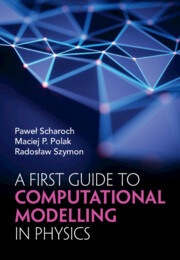Book contents
- Frontmatter
- Contents
- Preface
- How to Use the Book
- First Steps
- Project 1: Rectangular Finite Quantum Well – Stationary Schrödinger Equation in 1D
- Project 2: Diffraction of Light on a Slit
- Project 3: Pendulum as a Standard of the Unit of Time
- Project 4: Planetary System
- Project 5: Gravitation inside a Star
- Project 6: Normal Modes in a Cylindrical Waveguide
- Project 7: Thermal Insulation Properties of a Wall
- Project 8: Cylindrical Capacitor
- Advanced Projects
- Project 9: Coupled Harmonic Oscillators
- Project 10: The Fermi–Pasta–Ulam–Tsingou Problem
- Project 11: Hydrogen Star
- Project 12: Rectangular Quantum Well Filled with Electrons – The Idea of Self-Consistent Calculations
- Project 13: Time Dependent Schrödinger Equation
- Project 14: Poisson’s Equation in 2D
- Appendix A: Supplementary Materials
- Further Reading
- Index
Project 8: - Cylindrical Capacitor
Published online by Cambridge University Press: 01 February 2024
- Frontmatter
- Contents
- Preface
- How to Use the Book
- First Steps
- Project 1: Rectangular Finite Quantum Well – Stationary Schrödinger Equation in 1D
- Project 2: Diffraction of Light on a Slit
- Project 3: Pendulum as a Standard of the Unit of Time
- Project 4: Planetary System
- Project 5: Gravitation inside a Star
- Project 6: Normal Modes in a Cylindrical Waveguide
- Project 7: Thermal Insulation Properties of a Wall
- Project 8: Cylindrical Capacitor
- Advanced Projects
- Project 9: Coupled Harmonic Oscillators
- Project 10: The Fermi–Pasta–Ulam–Tsingou Problem
- Project 11: Hydrogen Star
- Project 12: Rectangular Quantum Well Filled with Electrons – The Idea of Self-Consistent Calculations
- Project 13: Time Dependent Schrödinger Equation
- Project 14: Poisson’s Equation in 2D
- Appendix A: Supplementary Materials
- Further Reading
- Index
Summary
This chapter discusses the application of the variational principle and finite element (FE) methods to electrostatic systems, using a cylindrical capacitor as a representative example. The variational principle, which identifies the solution that minimises a system’s total energy, provides a foundation for numerical techniques such as the FE methods. These methods offer flexibility in the selection of points in the independent variable space, which can be adapted according to the expected function behaviour. The system of focus is a capacitor comprising two coaxial metallic cylinders, chosen for its high symmetry and real-world relevance in areas like telecommunication cables. The chapter presents the Poisson’s equation, demonstrates the variational principle, and introduces the FE method. A numerical example of a cylindrical capacitor is also provided, illustrating how to convert the problem into one of functional minimisation using Poisson’s equation and then solve it using the FE method. The Gauss–Seidel iterative minimisation procedure is used in the solution process. The discussion provides a foundation for extending these methods to 2D and 3D systems in subsequent chapters.
Keywords
- Type
- Chapter
- Information
- A First Guide to Computational Modelling in Physics , pp. 52 - 56Publisher: Cambridge University PressPrint publication year: 2024



